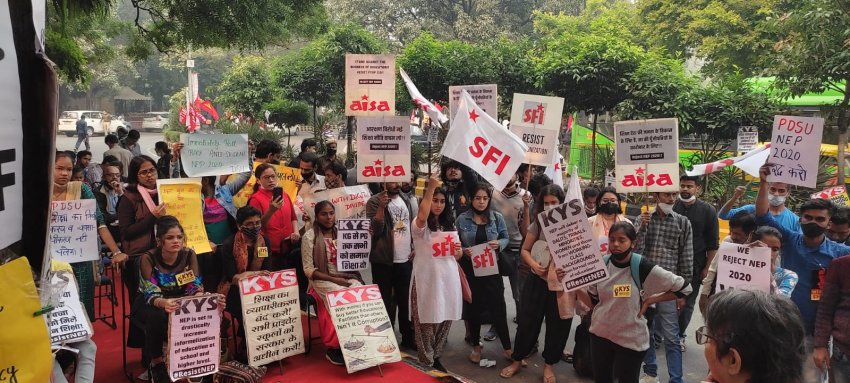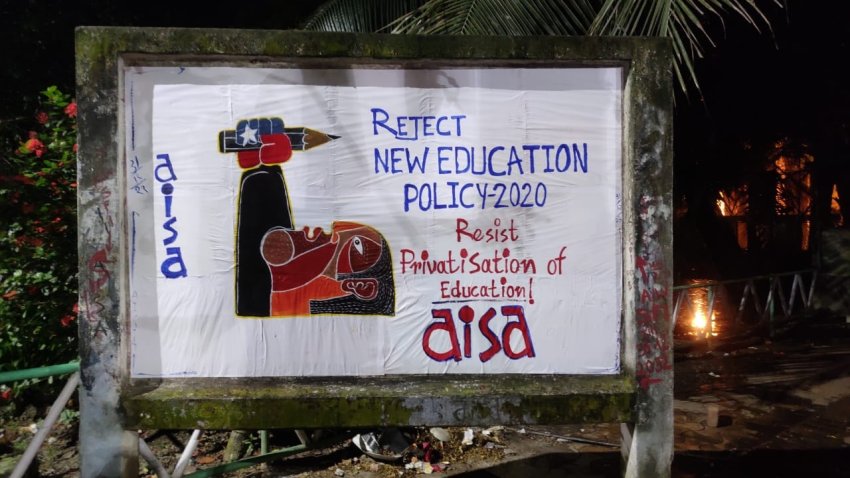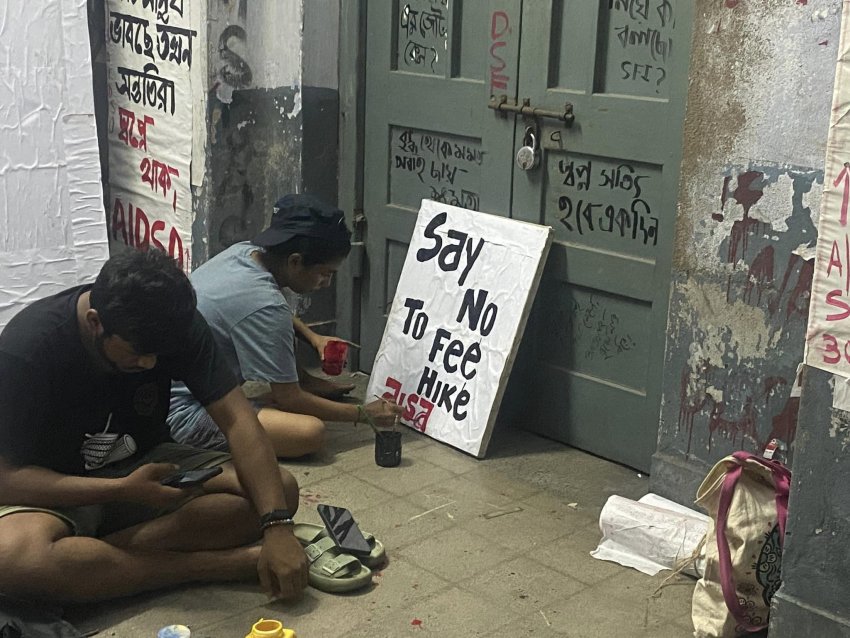
Students’ access to university education in India is threatened by the Narendra Modi regime’s National Education Policy (NEP), which was introduced in 2020.
The Bharatiya Janata Party (BJP) claims the NEP is an attempt to modernise higher education by “building a global best education system rooted in Indian ethos” and “transforming India into a global knowledge superpower”. But in reality, the NEP is a thinly veiled exercise in gutting the public university system and reinforcing Hindutva ideology.
Historically, India has had a strong public education system, with free and compulsory education from 6‒14 years of age embedded in its constitution. There is also a reservation, or quota, system for disadvantaged groups such as scheduled castes and tribes.
However, as former All India Students Association (AISA) president N Sai Balaji argued in Liberation in July, “the second term of Modi government … represents a complete destruction of public funded education and institutions governing them”. He argued universities are being transformed into a “centralised, corporatised and communalised model that stands against policies of inclusive, affordable and accessible education”.
“If earlier policies promoted privatisation of education, NEP 2020 goes a further step in corporatising education and in institutionalizing privatized education as the new normal.”
While India’s education system does need a “radical overhaul”, according to Communist Party of India (Marxist-Leninist) Liberation national general secretary Dipankar Bhattacharya, the NEP is a disaster.
“[The NEP] is designed to exclude and close the gates of education for the vast majority of India’s poor and deprived students; weaken social justice and reservations; open the floodgates for privatised, commercialised education; and institutionalise what Dr [Bhimrao Ramji] Ambedkar called ‘graded inequality’.”
394 - nep_banner_cr_aisa_jadavpur_university_unit.jpg

Introduction by stealth
The NEP was introduced in the midst of the COVID-19 lockdown in India, without debate or discussion. It was passed in an empty parliament while the media was focused on the pandemic.
This means that many people are not aware of the changes being introduced. AISA members at Jadavpur University (JU), in Kolkata, told Green Left that “even among university students, there is a lack of understanding about how the changes will impact them”.
This has made it difficult for the left to organise mass actions against the bill, so student activists have prioritised building awareness through educational seminars, producing pamphlets and holding speak-outs.
The NEP puts in place a model where students will have to take out loans to pay for increased education costs. This will lead to students being burdened with huge debts from a young age, as is the current situation in the United States and Australia.
It also promotes a shift to 40% online education — a baffling decision in a country where only 52% of the population had access to the internet in 2022 and only 11% had access to a computer in 2019. The number of people with internet and computer access is even lower in rural areas.
India is also allowing foreign universities to establish campuses in India — including Deakin, Wollongong and Western Sydney Universities — to encourage foreign investment.
Another element is the shift from three-year degrees to a four-year undergraduate program (FYUP). An extra year of study means attaining a degree will be more expensive and inaccessible. The FYUP model encourages students to leave their studies early, with a certificate or diploma, instead of addressing the issues that lead to high drop-out rates.
“It is those from [disadvantaged] classes, castes and genders who drop out: and it is those who will continue to drop out,” said Bhattacharya.
The NEP cuts arts and social science degrees, increasing the focus on vocational education, to produce a more skilled workforce to meet the needs of big capital.
Distorting history
The NEP is not only designed to push privatisation and boost corporate profits, there is a sinister underlying motive that the Modi regime is pursuing — promoting Hindutva ideology by erasing history.
Parts of the syllabus are being altered to present a radically different view of history that centres Hindutva and the Rashtriya Swayamsevak Sangh (RSS).
“Efforts are being made to falsify history through deletion of chapters concerning the Mughal period, Gujarat riots and democratic movements … [The government] is also infusing propaganda by adding chapters on [Vinayak Damodar] Savarkar, [Madhav Sadashivrao] Golwalkar and other icons of Sangh Parivar who sided with the British colonial legacy, propagated and institutionalised the politics of hate that the Hindutva fascist ideology symbolises,” Balaji wrote. (Sangh Parivar is an umbrella term for Hindutva organisations connected to the RSS, including the BJP.)
Departments at Delhi University and others have been forced to close courses on caste, gender and other forms of discrimination. These changes entrench “existing unequal structures that promote discrimination”.
At a JU seminar discussing the NEP that GL attended, Professor Manas Ghosh explained how the BJP is attempting to “exclude minorities from history”.
“Modi doesn’t want you to know about other cultures; if you don’t see them, you don’t get to meet them, or read about their cultures, groups like the Adivasi, if you delete them from our history they become absent from our present, too.”
The BJP is also using the NEP to promote pseudoscience, astrology and fraudulent medical claims, such as: drinking a mix of cow dung and urine will cure COVID-19.
A privatised education system will make it easier for the authorities to sack university staff who are critical of the BJP government and Hindutva.
nep_fee_hike_sign_cr_isaac_nellist.jpg

Resistance
Student organisations are at the forefront of the resistance against the NEP. AISA has made it a key national priority.
In May last year, AISA organised a national student parliament against the NEP, which involved students from 25 universities across the country. At AISA’s 10th National Conference in August, “Young India Wants Education and Dignified Jobs, Not Hate Mobs” was a central slogan.
In early November, 16 student organisations affiliated with left and opposition parties — including the All India Students' Federation, Students' Federation of India and the National Students' Union of India — formed a joint front against the NEP and student fee hikes.
Meanwhile, the BJP/RSS has ramped up repression of student activists, arresting and suspending many.
While the NEP has been adopted by the central government, it is still up to states to decide on its implementation.
Madhya Pradesh, Uttar Pradesh, Telangana, Maharashtra, Rajasthan, West Bengal and Assam have all begun implementing the NEP in various stages. Karnataka initially began implementing NEP but decided to scrap it in August.
After the West Bengal government announced in June its decision to implement the NEP, education activist Professor Ishita Mukherjee told NewsClick that the government had ignored its own committee’s recommendations.
“The government did not consult the stakeholders in the education process, including teachers, educationists, guardians, employees in educational institutions and academic officers,” she said.
“This process of forced and intentional privatisation will exclude the majority of students and turn education into a profit-making venture.”
As Balaji wrote, “The need of the hour is to unite and resist these draconian changes in education and reclaim our universities to create an inclusive and democratic society.”